A photo shared on Twitter the other day by London-based bicycling advocate and blogger Mark Treasure threw the differences between us and the Dutch into stark relief.
Mark pointed out how road designers in Utrecht (in the Netherlands) handled a situation where a road and its bicycle paths went under an overpass. The photo showed clearly how the quality and width of the bike paths were maintained — while the roadway was narrowed.
Here’s the photo:
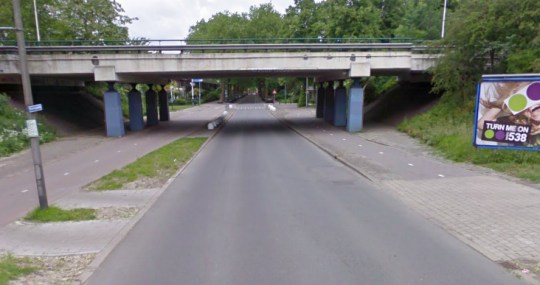
The photo immediately reminded me of a major pet peeve I have with our bicycling conditions here in Portland. Often, when a road with bike lanes travels under an overpass and some narrowing occurs, our solution is to either narrow or completely forget about the bicycle path in order to maintain the auto lane width. This happens all over the city and it shows a very serious lack of respect for bicycling. Below are a few examples…
The bike lanes just vanish on NE Lombard when it goes under 42nd (where people drive well over 40 mph too):
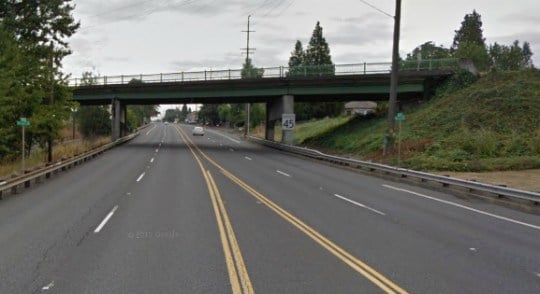
And there’s the one on N Interstate at the Larrabee ramp where the bike lane narrows to a width below the city’s own guidelines while the lane next to it maintains its width. (This one constantly worries me because of the mix of large trucks and high bicycle traffic volumes it sees everyday)…
Another one where bike lanes simply vanish is on NW Naito under the ramps for the Steel Bridge…
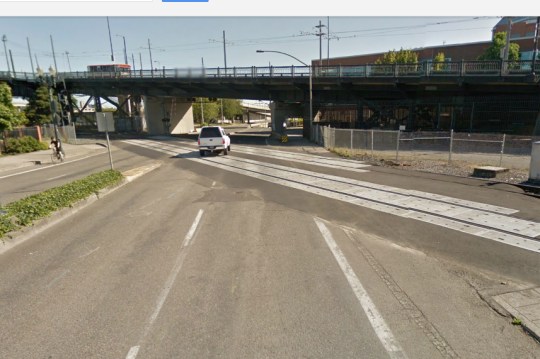
I realize these might not be apples-to-apples comparison with the Utrecht example, but the fact that our city and state roadway engineers cut out the bike facility in situations like this shows that while many officials and leaders will say, “Safety is our #1 priority!”, our design choices show a clear priority toward maintaining driving speeds and convenience at the expense of the cycling experience, while the Dutch design shows a priority for bicycling and safety of all road users.


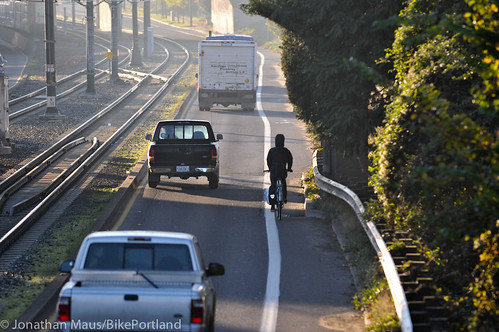

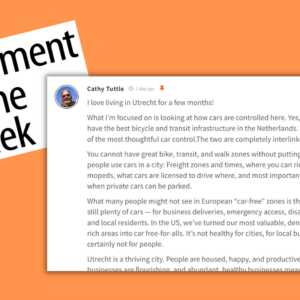
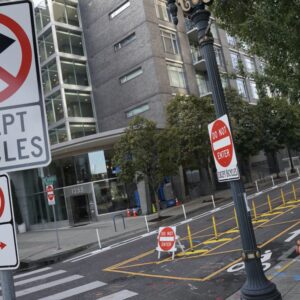
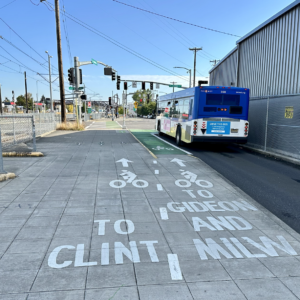
Thanks for reading.
BikePortland has served this community with independent community journalism since 2005. We rely on subscriptions from readers like you to survive. Your financial support is vital in keeping this valuable resource alive and well.
Please subscribe today to strengthen and expand our work.
The Interstate lane is problematic not only because it’s narrow but because motor vehicle traffic is going much faster than the posted speed (30). I estimate 10-15 MPH faster, and I have a good idea because I’ve driven through there as well as biked. They seem to treat the road as a divided highway.
Also, the lane is inadequately paved. Weird bumps in the asphalt — but seemingly only in the bike lane — every 50 feet or so. When I drove through there I used to wonder why cyclists hugged the white line, and now I know, they were trying to avoid the bumps.
Aside from the pavement quality issues, that location looks like it would be a good place to narrow the auto lane and put large turtle humps along the bike lane line. There are no left turns available and no reason to leave the bike lane except for the aforementioned pavement quality issues, which would have to be fixed. Normally, I’m not a fan of putting obstacles between the bike lane and the rest of the street, but if they were spaced correctly, turtle bumps could prove beneficial in keeping MVs out of the bike lane here, while still allowing cyclists to move left if needed.
you need to be able to leave the bike lane to pass, especially up that hill… I’m pretty slow so everybody usually goes around me…
The bumps! My god, the bumps! My panniers might be cheap, but nowhere else are they so consistently thrown off the rack.
You can’t make the auto lane any narrower on Interstate or the wide trucks will be driving in the bike paths.
Don’t forget about not-at-grade drain grates as well. I know the city is supposed to fix them when they’re reported, but there’s just so many of them.
There is a drain right at the narrowest part of the path under the Bway bridge overpass. The city is not (but should be) ashamed to let that stay and to route the N PDX Greenway anywhere nearby (let alone on Interstate).
How about comparing the worst undercrossing in Utrecht to the worst ones in Portland? Or, maybe, the best to the best? Apples to porcupine comparisons reveal a bias.
Jonathan is, thankfully and unabashedly, biased.
Y’know… during my year in the Netherlands, I just don’t remember encountering any “worst” infrastructure. What I think Americans sometimes struggle with realizing is that pictures from NL aren’t cherry-picking “great” examples — yes, the comfort and safety bar REALLY IS that high, and consistently so.
My memories of the worst:
– There was one intersection where I had to merge into traffic at 10-15 mph in a narrow space where a driver could theoretically door me — but Dutch drivers know better than to do that.
– Somehow riding onto a dangerous street where all the drivers were honking at me and yelling in English “This isn’t a street for bicycles – you’re going the wrong way”.
(rather than pretending that “complete streets” are possible – in which freight happily coexists inches away from bicyclists – they segregate streets by need and ensure each group gets a complete, but not identical, network.)
Sorry – just to be sure – the TRAFFIC was going 10-15 mph.
Thanks for the feedback… But I’m ok with people thinking I’m biased in this case. I am biased toward the type of road designs consistently applied in the NL and I am biased against the type of second-rate “In the American context” compromised to the hilt designs I see far too frequently here in Portland.
I’m certainly not complaining about your bias, but it would be very interesting to see the worst conditions in the Netherlands and Denmark. My bias is that our worst is far worse than theirs. We’re #1 (in crappy infrastructure)!
This idea that you’d need to pick the best to make a comparison keeps coming up. I make a point of not doing so. I do not write often about spectacular pieces of infrastructure because they’re not actually very important and they encourage a view that only the best bits are being written about. Not on my blog.
What is far more important than a few good pieces of infrastructure is to have a comprehensive network of very good quality infrastructure going everywhere in the country. That is what enables everyone to cycle to all their destinations.
Anyway, here’s an example of a bridge in the Netherlands which was considered to be so bad that the local campaigners made sure that Groningen lost a competition because of it. See what you make of that for quality.
It’s one of several posts which I’ve tagged as “we are not cherry picking” because I think it’s important to give an accurate impression of what is needed.
Or even more revealing would be consistency: How many Dutch underpasses look like the one in this posting (I would say nearly all are similiar or better); and how many underpasses in our Region look like the ones pictured in the blog posting (I would guess many of ours are similiar or worse and few are better).
Dick Schouten
As it happens, I put together a collection of thes in NL two years ago. Nothing special about the Utrecht example, it’s just normal for The Netherlands:
http://www.aviewfromthecyclepath.com/2011/08/space-under-and-over-bridges.html
SO MANY narrow points on bridges and underpasses everywhere in oregon. the bike lane (or shoulder) ends when you are most vulnerable. also, in your Naito example, lanes that cross tracks at an angle are especially dangerous. as if tracks aren’t bad enough, the steep angle makes it so much worse.
I just encountered this issue riding south on 99E (SE McLoughlin Blvd) just south of Sellwood this past Tuesday. Wide shoulder nearly disappears under the overpass, forcing a merge with fast-moving traffic. Here’s a Google Streetview link.
And people in cars are not friendly to people on bikes on that stretch of road. I was yelled at more than once, one time as my tires were rolling over a bicycle stencil in the shoulder someone yelled at me, “Get offa the road!”
I want an over size banner or flag or some such thing designed like the “Hello My Name IS:” stickers to fly behind my bike. The name space will say,”GET THE F(*& OUTTA THE ROAD!”.
That way I can wave and smile every time.
That was the one that immediately came to mind for me as well. If it is the same one I’m thinking of it is just South of downtown Milwaukie. The bridge is a railroad bridge.
I’ve noticed that some of the 99E bridges have closed off pedestrian underpasses… even the one in your example has a path for pedestrians away from the road, but there’s no space for bikes… they could route bikes up over the curb and onto the other side of those cement pillars if it’s wide enough… looks like that bridge could use an update anyway…
The infamous “two bridges” on Barbur illustrate this kind of design too.
I can also think of several spots on Beaverton-Hillsdale Highway eastbound where the bike lane is narrowed, without any change in the the car/truck lanes or the rarely-used center two-way turn lane. It looks like this will continue to be the case when they stripe the apparent new buffered bike lane on the Portland portion of BHH, and it looks like the buffer itself will be narrowed by about a foot in places where the road is constricted, but at least it will be better than it is today.
The most astounding bike-lane squeeze on BHH is in front of the Raleigh Hills Key Bank, just east of 65th and outside the Portland city boundary, where the bike lane is pinched to maybe 3′ while the other lanes maintain luxurious width. The jaw-dropper on this is that when they built this bank branch 2-3 years ago, they made sure to rebuild the very wide sidewalk back out to its original width so it would continue to squeeze the bike lane. Incredible.
And also beyond the Portland limit, the Raleigh Hills – Beaverton stretch of BHH doesn’t have a continuous bike lane at all. It comes and goes depending on whether ODOT thought there was room for one while maintaining ridiculously wide car/truck lanes. There are also sections where there clearly IS enough room but they didn’t bother striping a bike lane. The only thing that makes this situation less intolerable than Barbur is that this stretch of BHH has a semi-reasonable alternate route for bikes.
sorry about the italics.
Thanks, Jonathan Maus, for continuing to highlight these obviously dangerous places that threaten the safety of bicyclist BY DESIGN. I have communicated a bit with PBOT to alert them to the danger of that disappearing bike lane at the overpass on Interstate; there response was that crash data do not support any sort of remedy. I responded that I can appreciate the high cost of widening the road there, but recommended some fairly inexpensive, interim band-aids (and a few more visionary ideas,too) that I think could greatly improve safety.:
1. add a sign warning buses/trucks/cars AND bikes that both lanes are narrowing ahead. Once step further would be to officially make this short stretch a sharrow, because that is how it is functioning now! (I took a tape measure out there one day and the driving lane is less that 10.5′, the bike lane is less than 2.5′ including a drain meaning that there is not enough room for a bus and bike to be there at the same time. Period.
2. Paint an 11′ bus/truck/car lane adjacent to the MAX tracks in each direction instead of a 5′ or less gutter lane for bikes. Alternatively, leave the bike striped so that the buffer is revealed, and its disappearance can be anticipated by all users.
3. relocate the inlet and ramp up the entire street to curb height for a 20′ on either side of the bridge. put cable barrier along the MAX and a new curb. Remove the guardrail from the bridge wall and I think you could can add about 2-2.5 feet to the road width, maybe more.. Add a couple of speed bumps before this to slow everyone down because if speed could be controlled, cars/trucks/buses could operate much closer to the MAX.
4. Route the bike lane around the west side of the bridge column.
5, Close the viaduct to cars, make it planted promenade a la the Highline. Add a new bike ramp down to continue southbound. Cars/trucks/buses could simply use the existing left turn signal just under the bridge.
I was passed by cars as I was under the overpass today and it was not comfortable and there are often heavy trucks (sometimes double-length cement trucks). I think this section should be banned for trucks (with them re-routed on the off-ramp since they usually turn left to get up to Broadway at the next signal anyway). Maybe there are weight restrictions that wouldn’t allow it, but it is only a matter of time before one of them crunches someone on a bike.
Also, would it hurt the PBOT to get rid of the 3 (4 if you count the one by the manhole cover) big bumps on this stretch of road?
Blake those three big bumps just before this overpass ar seams in the asphalt that never got rolled. A couple of years ago, I saw a crew out “working on” them. Instead of grinding them smooth, they just patched them, making them even bigger!!
I remember that. It was because there were gaps opening up between them and the bumps were presumably seen to be less of an issue (maybe?). It has been an issue for as long as I’ve been riding down Interstate daily, which is about 6-7 years at this point.
I wonder if there is a criminal negligence issue here? Would it be acceptable for parts of the auto network to just vanish and leave drivers, say, sharing space with fast-moving freight trains… on an interstate? Probably not. And if the gov’t had allowed such a situation to transpire, they would be criminally negligent.
So, why is it different for bikes/peds? Shouldn’t they also have a complete network, without gaps that put them at risk of death or injury due to a lack of a complete network? Isn’t the failure to provide such a network an act of criminal negligence on the part of the government?
I’m just curious if this line of legal inquiry has ever been pursued, as it obviously keeps coming up, with deaths and serious injuries as a result, all over America…
I read this recently about legal justification for tar sands protest. Maybe similar? http://www.resilience.org/stories/2013-08-16/civil-disobedience-as-law-enforcement
This is how all bicycle infrastructure is in Nederland. We also pay much higher taxes to support this type of infrastructure. Our petrol tax alone is around $4.50 USD and we pay much higher monthly costs simply for owning an auto plus our tax rate is 50-52% depending on your earnings. We have wonderful infrastructure, but we also pay much more for it than Americans do. I think most of your taxes go to the freeways yes?
Most of our motor vehicle user fees (gas taxes, licensing, tolls) go to federal projects like freeways, yes, but those taxes only cover about two-thirds of those projects. Local roads are mostly funded by taxes on property, business, sales, etc., not by user fees. Of our federal income taxes, only a few percent goes to transportation including roads as well as other modes.
Ironically, I’ve just read this article whilst visiting Holland. Today I rode from Amsterdam to Utrecht and even rode through a few underpasses.
The infrastructure here is outstanding. It made for an exceptionally enjoyable day of exploration.
Couldn’t they put a strip of pavement in that goes around the overpass support?